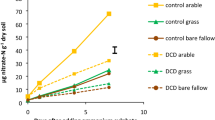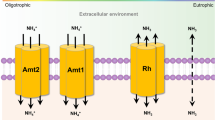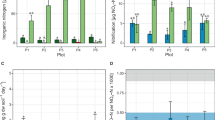Abstract
Ammonium/ammonia is the sole energy substrate of ammonia oxidizers, and is also an essential nitrogen source for other microorganisms. Ammonia oxidizers therefore must compete with other soil microorganisms such as methane-oxidizing bacteria (MOB) in terrestrial ecosystems when ammonium concentrations are limiting. Here we report on the interactions between nitrifying communities dominated by ammonia-oxidizing archaea (AOA) and Nitrospira-like nitrite-oxidizing bacteria (NOB), and communities of MOB in controlled microcosm experiments with two levels of ammonium and methane availability. We observed strong stimulatory effects of elevated ammonium concentration on the processes of nitrification and methane oxidation as well as on the abundances of autotrophically growing nitrifiers. However, the key players in nitrification and methane oxidation, identified by stable-isotope labeling using 13CO2 and 13CH4, were the same under both ammonium levels, namely type 1.1a AOA, sublineage I and II Nitrospira-like NOB and Methylomicrobium-/Methylosarcina-like MOB, respectively. Ammonia-oxidizing bacteria were nearly absent, and ammonia oxidation could almost exclusively be attributed to AOA. Interestingly, although AOA functional gene abundance increased 10-fold during incubation, there was very limited evidence of autotrophic growth, suggesting a partly mixotrophic lifestyle. Furthermore, autotrophic growth of AOA and NOB was inhibited by active MOB at both ammonium levels. Our results suggest the existence of a previously overlooked competition for nitrogen between nitrifiers and methane oxidizers in soil, thus linking two of the most important biogeochemical cycles in nature.
Similar content being viewed by others
Log in or create a free account to read this content
Gain free access to this article, as well as selected content from this journal and more on nature.com
or
References
Attard E, Poly F, Commeaux C, Laurent F, Terada A, Smets BF et al. (2010). Shifts between Nitrospira- and Nitrobacter-like nitrite oxidizers underlie the response of soil potential nitrite oxidation to changes in tillage practices. Environ Microbiol 12: 315–326.
Blainey PC, Mosier AC, Potanina A, Francis CA, Quake SR . (2011). Genome of a low-salinity ammonia-oxidizing archaeon determined by single-cell and metagenomic analysis. PLoS One 6: e16626.
Bodelier PLE, Laanbroek HJ . (2004). Nitrogen as a regulatory factor of methane oxidation in soils and sediments. FEMS Microbiol Ecol 47: 265–277.
Bodelier PLE . (2011). Interactions between nitrogenous fertilizers and methane cycling in wetland and upland soils. Curr Opin Environ Sustainability 3: 379–388.
Boyett MR, Tavakkoli A, Sobolev D . (2013). Mathematical modeling of competition for ammonium among Bacteria, Archaea and cyanobacteria within cyanobacterial mats: can ammonia-oxidizers force nitrogen fixation? Ocean Sci J 48: 269–277.
Chain P, Lamerdin J, Larimer FW, Regala W, Lao V, Land M et al. (2003). Complete genome sequence of the ammonia-oxidizing bacterium and obligate chemolithoautotroph Nitrosomonas europaea. J Bacteriol 185: 2759–2773.
Daebeler A, Abell GCJ, Bodelier PLE, Bodrossy L, Frampton DMF, Hefting MM et al. (2012). Archaeal dominated ammonia-oxidizing communities in Icelandic grassland soils are moderately affected by long-term N fertilization and geothermal heating. Fronti Microbiol 3: 352.
Di HJ, Cameron KC, Shen JP, Winefield CS, O'Callaghan M, Bowatte S et al. (2009). Nitrification driven by bacteria and not archaea in nitrogen-rich grassland soils. Nat Geosci 2: 621–624.
Ehrich S, Behrens D, Lebedeva E, Ludwig W, Bock E . (1995). A new obligately chemolithoautotrophic, nitrite-oxidizing bacterium,Nitrospira moscoviensis sp. nov. and its phylogenetic relationship. Arch Microbiol 164: 16–23.
Epskamp S, Cramer AOJ, Waldorp LJ, Schmittmann VD, Borsboom D . (2012). qgraph: network visualizations of relationships in psychometric data. J Stat Softw 48: 1–18.
Etiope G, Fridriksson T, Italiano F, Winiwarter W, Theloke J . (2007). Natural emissions of methane from geothermal and volcanic sources in Europe. J Volcanol Geoth Res 165: 76–86.
Freitag A, Bock E . (1990). Energy conservation in Nitrobacter. FEMS Microbiol Lett 66: 157–162.
Freitag TE, Chang L, Clegg CD, Prosser JI . (2005). Influence of inorganic nitrogen management regime on the diversity of nitrite-oxidizing bacteria in agricultural grassland soils. Appl Environ Microbiol 71: 8323–8334.
French E, Kozlowski JA, Mukherjee M, Bullerjahn G, Bollmann A . (2012). Ecophysiological characterization of ammonia-oxidizing archaea and bacteria from freshwater. Appl Environ Microbiol 78: 5773–5780.
Fruchterman TMJ, Reingold EM . (1991). Graph drawing by force-directed placement. Softw Pract Exp 21: 1129–1164.
Gorman-Lewis D, Martens-Habbena W, Stahl DA . (2014). Thermodynamic characterization of proton-ionizable functional groups on the cell surfaces of ammonia-oxidizing bacteria and archaea. Geobiology 12: 157–171.
Gruber N, Galloway JN . (2008). An Earth-system perspective of the global nitrogen cycle. Nature 451: 293–296.
Gubry-Rangin C, Hai B, Quince C, Engel M, Thomson BC, James P et al. (2011). Niche specialization of terrestrial archaeal ammonia oxidizers. Proc Natl Acad Sci USA 108: 21206–21211.
Hallam SJ, Konstantinidis KT, Putnam N, Schleper C, Watanabe Y-i, Sugahara J et al. (2006). Genomic analysis of the uncultivated marine crenarchaeote Cenarchaeum symbiosum. Proc Natl Acad Sci USA 103: 18296–18301.
Hamilton TL, Koonce E, Howells A, Havig JR, Jewell T, de la Torre JR et al. (2014). Competition for ammonia influences the structure of chemotrophic communities in geothermal springs. Appl Environ Microbiol 80: 653–661.
Hatzenpichler R, Lebedeva EV, Spieck E, Stoecker K, Richter A, Daims H et al. (2008). A moderately thermophilic ammonia-oxidizing crenarchaeote from a hot spring. Proc Natl Acad Sci USA 105: 2134–2139.
Ingalls AE, Shah SR, Hansman RL, Aluwihare LI, Santos GM, Druffel ERM et al. (2006). Quantifying archaeal community autotrophy in the mesopelagic ocean using natural radiocarbon. Proc Natl Acad Sci USA 103: 6442–6447.
Jia Z, Conrad R . (2009). Bacteria rather than Archaea dominate microbial ammonia oxidation in an agricultural soil. Environ Microbiol 11: 1658–1671.
Jung M-Y, Park S-J, Min D, Kim J-S, Rijpstra WIC, Sinninghe Damsté JS et al. (2011). Enrichment and characterization of an autotrophic ammonia-oxidizing archaeon of mesophilic crenarchaeal group I.1a from an agricultural soil. Appl Environ Microbiol 77: 8635–8647.
Jung M-Y, Well R, Min D, Giesemann A, Park S-J, Kim J-G et al. (2013). Isotopic signatures of N2O produced by ammonia-oxidizing archaea from soils. ISME J 8: 1115–1125.
Ke X, Angel R, Lu Y, Conrad R . (2013). Niche differentiation of ammonia oxidizers and nitrite oxidizers in rice paddy soil. Environ Microbiol 15: 2275–2292.
Kim J-G, Jung M-Y, Park S-J, Rijpstra WIC, Sinninghe Damsté JS, Madsen EL et al. (2012). Cultivation of a highly enriched ammonia-oxidizing archaeon of thaumarchaeotal group I.1b from an agricultural soil. Environ Microbiol 14: 1528–1543.
Koops H-P, Pommerening-Röser A . (2001). Distribution and ecophysiology of the nitrifying bacteria emphasizing cultured species. FEMS Microbiol Ecol 37: 1–9.
Laanbroek H, Gerards S . (1993). Competition for limiting amounts of oxygen between Nitrosomonas europaea and Nitrobacter winogradskyi grown in mixed continuous cultures. Arch Microbiol 159: 453–459.
Lehtovirta-Morley LE, Stoecker K, Vilcinskas A, Prosser JI, Nicol GW . (2011). Cultivation of an obligate acidophilic ammonia oxidizer from a nitrifying acid soil. Proc Natl Acad Sci USA 108: 15892–15897.
Leininger S, Urich T, Schloter M, Schwark L, Qi J, Nicol GW et al. (2006). Archaea predominate among ammonia-oxidizing prokaryotes in soils. Nature 442: 806–809.
Levicnik-Hofferle S, Nicol GW, Ausec L, Mandic-Mulec I, Prosser JI . (2012). Stimulation of thaumarchaeal ammonia oxidation by ammonia derived from organic nitrogen but not added inorganic nitrogen. FEMS Microbiol Ecol 80: 114–123.
Lipschultz F, Zafiriou OC, Wofsy SC, McElroy MB, Valois FW, Watson SW . (1981). Production of NO and N2O by soil nitrifying bacteria. Nature 294: 641–643.
Lu L, Jia Z . (2013). Urease gene-containing Archaea dominate autotrophic ammonia oxidation in two acid soils. Environ Microbiol 15: 1795–1809.
Lueders T, Manefield M, Friedrich MW . (2004). Enhanced sensitivity of DNA- and rRNA-based stable isotope probing by fractionation and quantitative analysis of isopycnic centrifugation gradients. Environ Microbiol 6: 73–78.
Maixner F, Noguera DR, Anneser B, Stoecker K, Wegl G, Wagner M et al. (2006). Nitrite concentration influences the population structure of Nitrospira-like bacteria. Environ Microbiol 8: 1487–1495.
Martens-Habbena W, Berube PM, Urakawa H, de la Torre JR, Stahl DA . (2009). Ammonia oxidation kinetics determine niche separation of nitrifying Archaea and Bacteria. Nature 461: 976–979.
Martens-Habbena W, Stahl DA . (2011). Nitrogen metabolism and kinetics of ammonia-oxidizing archaea. Method Enzymol 496: 465–487.
Mincer TJ, Church MJ, Taylor LT, Preston C, Kar DM, DeLong EF . (2007). Quantitative distribution of presumptive archaeal and bacterial nitrifiers in Monterey Bay and the North Pacific Subtropical Gyre. Environ Microbiol 9: 1162–1175.
Mussmann M, Brito I, Pitcher A, Damste JSS, Hatzenpichler R, Richter A et al. (2011). Thaumarchaeotes abundant in refinery nitrifying sludges express amoA but are not obligate autotrophic ammonia oxidizers. Proc Natl Acad Sci USA 108: 16771–16776.
Nakagawa T, Stahl DA . (2013). Transcriptional response of the archaeal ammonia oxidizer Nitrosopumilus maritimus to low and environmentally relevant ammonia concentrations. Appl Environ Microbiol 79: 6911–6916.
Norton JM, Klotz MG, Stein LY, Arp DJ, Bottomley PJ, Chain PSG et al. (2008). Complete genome sequence of nitrosospira multiformis, an ammonia-oxidizing bacterium from the soil environment. Appl Environ Microbiol 74: 3559–3572.
Nyerges G, Han S-K, Stein LY . (2010). Effects of ammonium and nitrite on growth and competitive fitness of cultivated methanotrophic bacteria. Appl Environ Microbiol 76: 5648–5651.
Offre P, Prosser JI, Nicol GW . (2009). Growth of ammonia-oxidizing archaea in soil microcosms is inhibited by acetylene. FEMS Microbiol Ecol 70: 99–108.
Oksanen J, Blanchet G, Kindt R, Legendre P, O’Hara RG, Simpson GL et al. (2010). Vegan: community ecology package. R package version 1.17-1. Available at: http://CRAN.R-project.org/package=vegan.
Ouverney CC, Fuhrman JA . (2000). Marine planktonic archaea take up amino acids. Appl Environ Microbiol 66: 4829–4833.
Park B-J, Park S-J, Yoon D-N, Schouten S, Sinninghe Damste JS, Rhee S-K . (2010). Cultivation of autotrophic ammonia-oxidizing archaea from marine sediments in coculture with sulfur-oxidizing bacteria. Appl Environ Microbiol 76: 7575–7587.
Pester M, Rattei T, Flechl S, Gröngröft A, Richter A, Overmann J et al. (2011). amoA-based consensus phylogeny of ammonia-oxidizing archaea and deep sequencing of amoA genes from soils of four different geographic regions. Environ Microbiol 14: 525–539.
Pratscher J, Dumont MG, Conrad R . (2011). Ammonia oxidation coupled to CO2 fixation by archaea and bacteria in an agricultural soil. Proc Natl Acad Sci USA 108: 4170–4175.
Prosser JI . (1989). Autotrophic nitrification in bacteria. Adv Microb Physiol 30: 125–181.
Schloss PD, Westcott SL, Ryabin T, Hall JR, Hartmann M, Hollister EB et al. (2009). Introducing mothur: open-source, platform-independent, community-supported software for describing and comparing microbial communities. Appl Environ Microbiol 75: 7537–7541.
Schloss PD, Gevers D, Westcott SL . (2011). Reducing the effects of PCR amplification and sequencing artifacts on 16S rRNA-based studies. PLoS One 6: e27310.
Schramm A, de Beer D, van den Heuvel JC, Ottengraf S, Amann R . (1999). Microscale distribution of populations and activities of Nitrosospira and Nitrospira spp. along a macroscale gradient in a nitrifying bioreactor: quantification by in situ hybridization and the use of microsensors. Appl Environ Microbiol 65: 3690–3696.
Semrau JD, Dispirito AA, Vuilleumier S . (2011). Facultative methanotrophy: false leads, true results, and suggestions for future research. FEMS Microbiol Lett 323: 1–12.
Spang A, Poehlein A, Offre P, Zumbragel S, Haider S, Rychlik N et al. (2012). The genome of the ammonia-oxidizing Candidatus Nitrososphaera gargensis: insights into metabolic versatility and environmental adaptations. Environ Microbiol 14: 3122–3145.
Stein LY, Daniel JA, Paul MB, Patrick SGC, Loren H, Mike SMJ et al. (2007). Whole-genome analysis of the ammonia-oxidizing bacterium, Nitrosomonas eutropha C91: implications for niche adaptation. Environ Microbiol 9: 2993–3007.
Stein LY, Klotz MG . (2011). Nitrifying and denitrifying pathways of methanotrophic bacteria. Biochem Soc Trans 39: 1826–1831.
Stein LY, Roy R, Dunfield PF . (2012) Aerobic Methanotrophy and Nitrification: Processes and Connections. eLS. John Wiley & Sons, Ltd.
Stopnisek N, Gubry-Rangin C, Hofferle S, Nicol GW, Mandic-Mulec I, Prosser JI . (2010). Thaumarchaeal ammonia oxidation in an acidic forest peat soil is not influenced by ammonium amendment. Appl Environ Microbiol 76: 7626–7634.
Tourna M, Freitag TE, Nicol GW, Prosser JI . (2008). Growth, activity and temperature responses of ammonia-oxidizing archaea and bacteria in soil microcosms. Environ Microbiol 10: 1357–1364.
Tourna M, Stieglmeier M, Spang A, Konneke M, Schintlmeister A, Urich T et al. (2011). Nitrososphaera viennensis, an ammonia oxidizing archaeon from soil. Proc Natl Acad Sci USA 108: 8420–8425.
Tully BJ, Nelson WC, Heidelberg JF . (2012). Metagenomic analysis of a complex marine planktonic thaumarchaeal community from the Gulf of Maine. Environ Microbiol 14: 254–267.
Urakawa H, Martens-Habbena W, Stahl DA . (2011). Physiology and genomics of ammonia-oxidizing archaea. In: Ward BB, Arp DJ, Klotz MG (eds) Nitrification. ASM Press: Washington, DC, pp 117–155.
Verhagen FJM, Laanbroek HJ, Woldendorp JW . (1995). Competition for ammonium between nitrifying bacteria and plant roots in soil pots; effects of grazing by flagellates and fertilization. Plant Soil 170: 241–250.
Verhamme DT, Prosser JI, Nicol GW . (2011). Ammonia concentration determines differential growth of ammonia-oxidising archaea and bacteria in soil microcosms. ISME J 5: 1067–1071.
Walker CB, de la Torre JR, Klotz MG, Urakawa H, Pinel N, Arp DJ et al. (2010). Nitrosopumilus maritimus genome reveals unique mechanisms for nitrification and autotrophy in globally distributed marine crenarchaea. Proc Natl Acad Sci USA 107: 8818–8823.
Xia WW, Zhang CX, Zeng XW, Feng YZ, Weng JH, Lin XG et al. (2011). Autotrophic growth of nitrifying community in an agricultural soil. ISME J 5: 1226–1236.
Zhang LM, Offre PR, He JZ, Verhamme DT, Nicol GW, Prosser JI . (2010). Autotrophic ammonia oxidation by soil thaumarchaea. Proc Natl Acad Sci USA 107: 17240–17245.
Acknowledgements
We thank Bjarni D Sigurdsson and the Agricultural University of Iceland for access to the sampling site and Bas Dingemans for collecting the soil samples. We also thank Roos Keijzer and Marion Meima-Franke for excellent technical assistance. The Schure-Beijerinck-Popping fund is acknowledged for funding the stay of AD as a guest researcher in the ZJ group. This study was partially supported by the Ministry of Science and Technology of China (2010DFA22770). This is publication number 5603 of The Netherlands Institute of Ecology (NIOO-KNAW).
Author information
Authors and Affiliations
Corresponding author
Ethics declarations
Competing interests
The authors declare no conflict of interest.
Additional information
Supplementary Information accompanies this paper on The ISME Journal website
Supplementary information
Rights and permissions
About this article
Cite this article
Daebeler, A., Bodelier, P., Yan, Z. et al. Interactions between Thaumarchaea, Nitrospira and methanotrophs modulate autotrophic nitrification in volcanic grassland soil. ISME J 8, 2397–2410 (2014). https://doi.org/10.1038/ismej.2014.81
Received:
Revised:
Accepted:
Published:
Issue date:
DOI: https://doi.org/10.1038/ismej.2014.81
Keywords
This article is cited by
-
Prevention of well clogging during aquifer storage of turbid tile drainage water rich in dissolved organic carbon and nutrients
Hydrogeology Journal (2023)
-
Arctic soil methane sink increases with drier conditions and higher ecosystem respiration
Nature Climate Change (2023)
-
Flow-through stable isotope probing (Flow-SIP) minimizes cross-feeding in complex microbial communities
The ISME Journal (2021)
-
Soil particle and moisture-related factors determine landward distribution of bacterial communities in a lateral riverside continuum of the Xilin River Basin
Soil Ecology Letters (2021)
-
Exploring the upper pH limits of nitrite oxidation: diversity, ecophysiology, and adaptive traits of haloalkalitolerant Nitrospira
The ISME Journal (2020)



